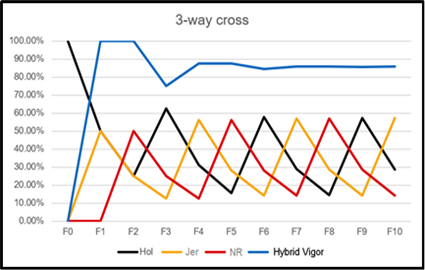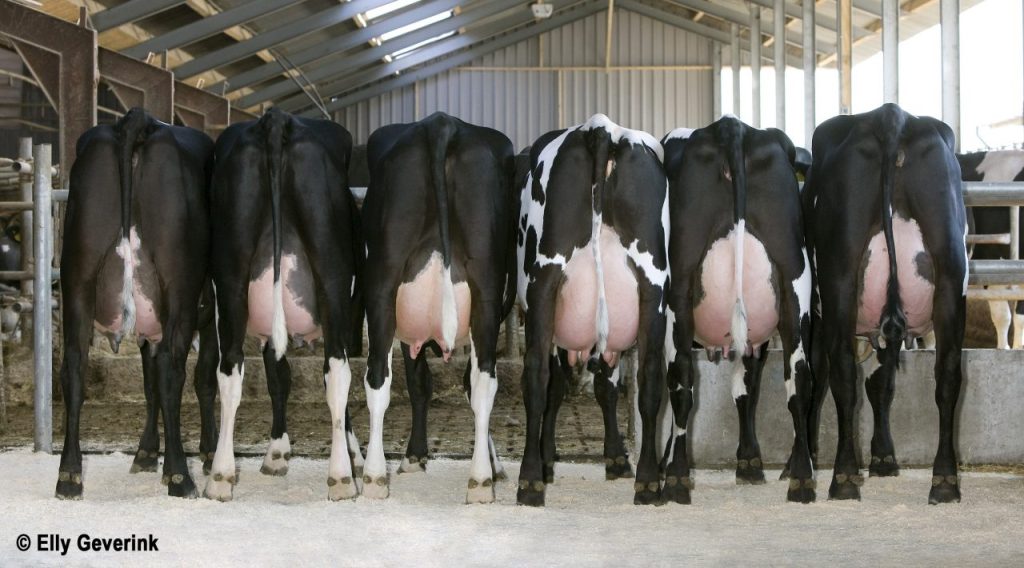Crossbreeding is all about breeding the kind of herd you want. Dairy crossbreeding creates cows to suit your system, your environment, and your nutrition.
1. Set priorities
Make a priority list of what it is you want to achieve from your crossbred herd. The more focused the list, the more impact you can make. Crossbreeding is a long-term commitment and will be very different from a purebred herd. So, it is important to always refer to your priorities when establishing your plan. Your priorities will determine which breeds and sires you consider.
2. Choose your dairy crossbreeding system
One of the main benefits of crossbreeding is hybrid vigor, which boosts herd health and reproduction. Dairy crossbreeding utilizes this benefit while also providing options. A two-way crossing system and a three-way crossing system provide different levels of hybrid vigor over time (see Figures 1 and 2). You may consider this when identifying your herd’s priorities. Whatever you choose, your plan should be simple and work for you. Remember – you have to milk the cows, so breed the kind you want! Read more about the benefits of crossbreeding.
3. Make an ABS dairy crossbreeding plan
At its simplest, crossbreeding involves two breeds to improve the traits you want to improve. Three-way crosses include three breeds and can increase hybrid vigor through generations. However, be wary of using three breeds only for hybrid vigor because this can lead to using breeds with undesirable traits.
Figures 1 and 2 show how hybrid vigor differs between a two-way crossing system and a three-way crossing system over time. Proper identification is critical to maximizing the benefits of your crossbreeding program. Whatever you choose, your plan should be practical, simple and suit your farm situation. Following the rotation is essential to maximizing the crossbreeding benefits. ABS has the programs and experience to help with identification and following your plan.
[READ: Dairy Crossbreeding Planning]

Figure 1: Two-way cross example
Starting with a Holstein herd, the black line represents the % of Holstein in each generation.
In this example, the Holsteins are 2 way crossed with Norwegian Red and the red line represents the % of Norwegian Red in each generation.
The blue line represents the % of heterosis or hybrid vigor in each generation.

Figure 2: Three-way cross example
Starting with a Holstein herd, the black line represents the % of Holstein in each generation.
In this example, the Holsteins are 3 way crossed with Jersey first and the yellow line represents the % of Jersey in each generation.
Norwegian Red is the third breed and the red line represents the % of Norwegian Red in each generation.
The blue line represents the % of heterosis or hybrid vigor in each generation
Identify which cows in your herd to crossbreed; you do not have to crossbreed all your cows. Also consider the number of replacement heifers you need; the use of sexed semen and dairy beef. Our advisors can help determine this using our Heifer Optimization Tool (HOT). ABS has the expertise and programs to help maximize the benefits of whatever strategy works for you.
4. Choose your breeds
Which breeds best transmit the high priority traits you are targeting? Want to improve fertility? Consider Norwegian Red. Looking for small cows with high solids %? Jersey should be on your list. To do this, you need to identify which breeds are most relevant or complementary to your herd. Our dairy crossbreeding specialists can help you decide which breeds will best suit your herd and choose between a two or three-way cross. Take a look at Table 1 for breed options and characteristics.
Table 1
| Breed | Contributes | Protect |
|---|---|---|
| Holstein | Milk volume, udders | Relative health, fertility, stature |
| Norwegian Red | Moderate stature, health, fertility, solids | Udders on very high producers |
| Jersey | Milk solids %, small cows | Udders, yield, size |
| Mountain breeds | Strength, solids yield | Size, weight, udders |
5. Choose your bulls
Once you have decided which ABS dairy crossbreeding system suits you, the final step is to select the bulls that match your herd’s priorities. Our dairy crossbreeding specialists can help you to make the right choice for your herd.
Contact us to get started with your dairy crossbreeding plan.






